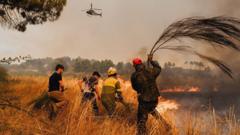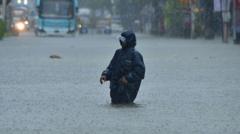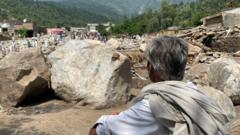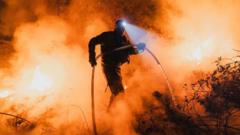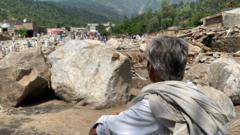The Rasuwa district in Nepal has been hit hard by devastating flash floods that resulted in the collapse of the main bridge to China, claiming lives and causing significant infrastructure damage. Rescuers continue to search for missing individuals amidst growing concerns over climate-related disasters in the region.
Nepal-China Bridge Collapses Amid Devastating Flash Floods

Nepal-China Bridge Collapses Amid Devastating Flash Floods
At least three confirmed dead as monsoon floods wreak havoc in Nepal, disrupting vital trade connections with China.
Flash floods in Nepal’s Rasuwa district have resulted in the confirmed deaths of at least three people and the destruction of the key bridge linking the country to China, the Nepal-China Friendship Bridge. The flooding, which began early Tuesday morning, has prompted urgent search and rescue operations to locate individuals who remain unaccounted for.
Initial assessments indicated extensive damage to critical infrastructure, including a customs yard where numerous vehicles and cargo containers were stationed. Reports of power outages also emerged, particularly impacting several hydropower plants in the region. The Nepal army and police utilized helicopters to conduct rescues, successfully retrieving nine individuals so far. However, concerns linger for the missing, including three police personnel, nine Nepali civilians, and six Chinese nationals.
The casualties among the police officers occurred while they were attempting to provide assistance during the flash floods, as revealed by Binod Ghimire, a spokesperson for the Nepal police. Most of the missing civilians are believed to be drivers engaged in transporting goods across the border.
Nepal is particularly susceptible to flash floods due to its mountainous terrain, with recent years witnessing an increase in the frequency and severity of such disasters. Experts cite shifting climate patterns as a contributing factor to heightened risks, with the monsoon season taking a toll on local communities dependent on agriculture and increasing incidents of landslides, avalanches, and glacial lake outbursts.
The broader region, including parts of India, has similarly suffered; reports from the Indian state of Himachal Pradesh reveal that nearly 80 people have died since June 20 due to flash floods and landslides, with at least 35 still missing. The Indian home ministry noted that during the last 24 hours, at least 14 fatalities were recorded across five states attributed to heavy rains and subsequent flooding.
As the monsoon season, which lasts from early June to September, persists, officials in both Nepal and India are bracing for the potential for further devastation, with communities left vulnerable in the face of changing environmental conditions.







